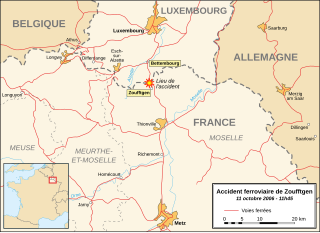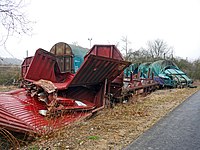
The Southall rail crash occurred on 19 September 1997, on the Great Western Main Line at Southall, West London. An InterCity 125 high speed passenger train (HST) failed to slow down in response to warning signals and collided with a freight train crossing its path, causing seven deaths and 139 injuries.

The Glenbrook rail accident occurred on 2 December 1999 at 8:22 am on a curve east of Glenbrook railway station on the CityRail network between Glenbrook and Lapstone, in the Blue Mountains of New South Wales, Australia. Seven passengers were killed and 51 passengers were taken to hospital with injuries when a CityRail electric interurban train collided with the rear wagon of the long-haul Perth-to-Sydney Indian Pacific.

The Breckland line is a secondary railway line in the east of England that links Cambridge in the west to Norwich in the east. The line runs through three counties: Cambridgeshire, Suffolk and Norfolk. It takes its name from the Breckland region of Norfolk and passes through Thetford Forest.

The Société Nationale des Chemins de Fer Luxembourgeois is the national railway company of Luxembourg. In 2023, it carried approximately 28.7 million passengers. As of 2023, the company employs around 5,000 people, making CFL the country's largest corporate employer.

The Thirsk rail crash occurred on 31 July 1967 at Thirsk, Yorkshire, England on the British Rail East Coast Main Line.

The 2006 Zoufftgen train collision occurred around 11.45 am on 11 October 2006, near Zoufftgen, Moselle, France, some 20 metres from the border with Luxembourg, on the Metz–Luxembourg railway line. Two trains collided head-on while one track of a double track line was out of service for maintenance. Six people, including the drivers of both trains, were killed: two Luxembourgers and four French. Twenty more were injured in the accident, two seriously.
There have been a number of train accidents on the railway network of Victoria, Australia. Some of these are listed below.
The railways of New South Wales, Australia have had many incidents and accidents since their formation in 1831. There are close to 1000 names associated with rail-related deaths in NSW on the walls of the Australian Railway Monument in Werris Creek. Those killed were all employees of various NSW railways. The details below include deaths of employees and the general public.

The 1984 Eccles rail crash occurred on 4 December 1984 at Eccles, Greater Manchester, when an express passenger train collided at speed with the rear of a freight train of oil tankers. The driver of the express and two passengers were killed, and 68 people were injured. The cause of the accident was determined to be that the driver of the express train had passed a signal at danger.
The Wrawby Junction rail crash was a train crash which occurred on 9 December 1983, at Wrawby Junction, near Barnetby station, North Lincolnshire, England.
The Knowle and Dorridge rail crash was a fatal rail crash that occurred at Dorridge railway station in Warwickshire, England, on 15 August 1963. Three people died in the crash after a signalman's error routed a small freight train into the path of an express passenger train which slowed but could not stop before colliding with it.
This article lists significant fatal, injury-only, and other accidents involving railway rolling stock, including crashes, fires and other incidents in the Australian state of South Australia. The first known incident in this list occurred in 1873 in Smithfield.
This is a list of significant railway accidents in Queensland, Australia.
This article is concerned with railway accidents occurring in Western Australia, where they are identified as fatal accidents, injury related accidents, or where infrastructure or rolling stock was damaged.








